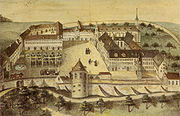
Elchingen Abbey
Encyclopedia
Elchingen Abbey was a Benedictine monastery in Oberelchingen (in Elchingen
) in Bavaria
, Germany
, in the diocese of Augsburg.
 Dedicated to the Virgin Mary and Saints Peter
Dedicated to the Virgin Mary and Saints Peter
and Paul
, the monastery was founded by the Counts of Dillingen. The abbey was reichsunmittelbar (independent of territorial sovereignty and answering directly to the Holy Roman Emperor
, and thus a territorial principality in its own right). The abbot sat in the Reichstag
of the Holy Roman Empire
.
The abbey was dissolved in 1802 during secularisation
. By 1840 the buildings had been almost entirely demolished.
In 1921 the Missionary Oblates of Mary Immaculate
settled on the site.
Elchingen
Elchingen is a municipality about 7 km east of Ulm–Neu-Ulm in the district of Neu-Ulm in Bavaria, GermanyMunicipality parts:* Thalfingen: 4 211 residents, 8.83 km²* Oberelchingen: 3 024 residents, 7.31 km²...
) in Bavaria
Bavaria
Bavaria, formally the Free State of Bavaria is a state of Germany, located in the southeast of Germany. With an area of , it is the largest state by area, forming almost 20% of the total land area of Germany...
, Germany
Germany
Germany , officially the Federal Republic of Germany , is a federal parliamentary republic in Europe. The country consists of 16 states while the capital and largest city is Berlin. Germany covers an area of 357,021 km2 and has a largely temperate seasonal climate...
, in the diocese of Augsburg.
History

Saint Peter
Saint Peter or Simon Peter was an early Christian leader, who is featured prominently in the New Testament Gospels and the Acts of the Apostles. The son of John or of Jonah and from the village of Bethsaida in the province of Galilee, his brother Andrew was also an apostle...
and Paul
Paul of Tarsus
Paul the Apostle , also known as Saul of Tarsus, is described in the Christian New Testament as one of the most influential early Christian missionaries, with the writings ascribed to him by the church forming a considerable portion of the New Testament...
, the monastery was founded by the Counts of Dillingen. The abbey was reichsunmittelbar (independent of territorial sovereignty and answering directly to the Holy Roman Emperor
Holy Roman Emperor
The Holy Roman Emperor is a term used by historians to denote a medieval ruler who, as German King, had also received the title of "Emperor of the Romans" from the Pope...
, and thus a territorial principality in its own right). The abbot sat in the Reichstag
Reichstag (Holy Roman Empire)
The Imperial Diet was the Diet, or general assembly, of the Imperial Estates of the Holy Roman Empire.During the period of the Empire, which lasted formally until 1806, the Diet was not a parliament in today's sense; instead, it was an assembly of the various estates of the realm...
of the Holy Roman Empire
Holy Roman Empire
The Holy Roman Empire was a realm that existed from 962 to 1806 in Central Europe.It was ruled by the Holy Roman Emperor. Its character changed during the Middle Ages and the Early Modern period, when the power of the emperor gradually weakened in favour of the princes...
.
The abbey was dissolved in 1802 during secularisation
German Mediatisation
The German Mediatisation was the series of mediatisations and secularisations that occurred in Germany between 1795 and 1814, during the latter part of the era of the French Revolution and then the Napoleonic Era....
. By 1840 the buildings had been almost entirely demolished.
In 1921 the Missionary Oblates of Mary Immaculate
Missionary Oblates of Mary Immaculate
The Missionary Oblates of Mary Immaculate is a missionary religious congregation in the Catholic Church. It was founded on January 25, 1816 by Saint Eugene de Mazenod, a French priest born in Aix-en-Provence in the south of France on August 1, 1782. The congregation was given recognition by Pope...
settled on the site.

